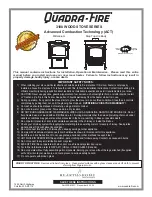
Osburn Matrix Installation and Operation Manual
28 ______________________________________________________________________________
5.2
FLUE AND FLUE SYSTEM MAINTENANCE
5.2.1
WHY FLUE SYSTEM CLEANING IS NECESSARY
Wood smoke can condense inside the flue and flue system, forming a combustible deposit called
creosote. If creosote is allowed to build up in the flue system it can ignite when a hot fire is burned
in the wood fire and a very hot fire can progress to the top of the flue system. Severe flue system
fires can damage even the best flue systems. Smouldering, smoky fires can quickly cause a thick
layer of creosote to form. When you avoid smouldering so the exhaust from the flue system is
mostly clear, creosote builds up more slowly. Your new wood fire has the right characteristics to
help you to burn clean fires with little or no smoke, resulting in less creosote in the flue system.
5.2.2
HOW OFTEN SHOULD YOU CLEAN THE FLUE SYSTEM?
It is not possible to predict how much or how quickly creosote will form in your flue system. It is
important, therefore, to check the build-up in your flue system monthly when getting used to the
new wood fire until you determine the rate of creosote formation. Even if creosote forms slowly in
your system, the flue system should be cleaned and inspected at least once each year.
Contact your local municipal or provincial fire authority for information on how to handle a flue
system fire. Have a clearly understood plan to handle a flue system fire.
5.2.3
CLEANING THE FLUE SYSTEM
Flue system cleaning can be a difficult and
dangerous job. If you don’t have
experience cleaning flue systems, you
might want to hire a professional flue
system sweep to clean and inspect the
system for the first time. After having seen
the cleaning process, you can decide if it is
a job you would like to take on.
The most common equipment used are
fibreglass rods with threaded fittings and
stiff plastic brushes. The brush is forced up
and down inside the flue system to scrub
off the creosote.
The flue should always be cleaned at the
same time the flue system is cleaned.
CAUTION:
Operation of your wood fire without the baffle may cause unsafe and hazardous
temperature conditions and will void the warranty
.
NOTE:
Before installing the firebrick, check to
ensure that none are broken or damaged in any way. If so, have the damaged ones replaced.
Check the firebrick for damage at least annually and replace any broken or damaged ones with
new ones. Inspection and cleaning of the flue system is facilitated by the removable baffle.
















































